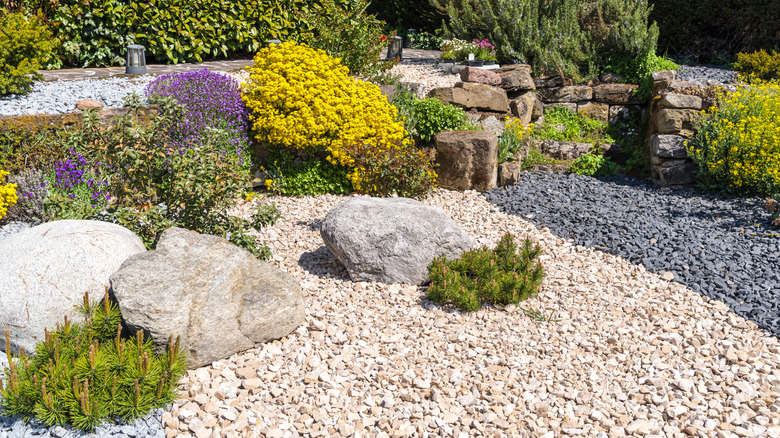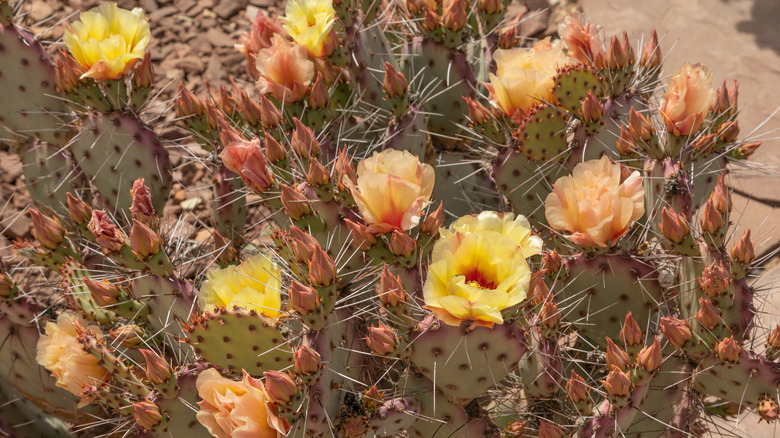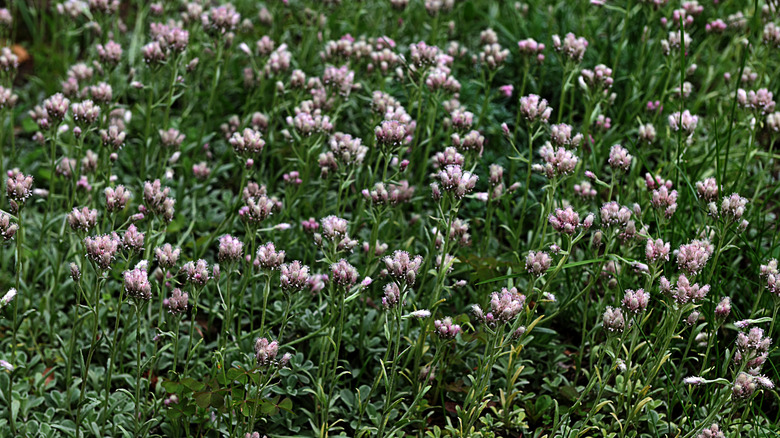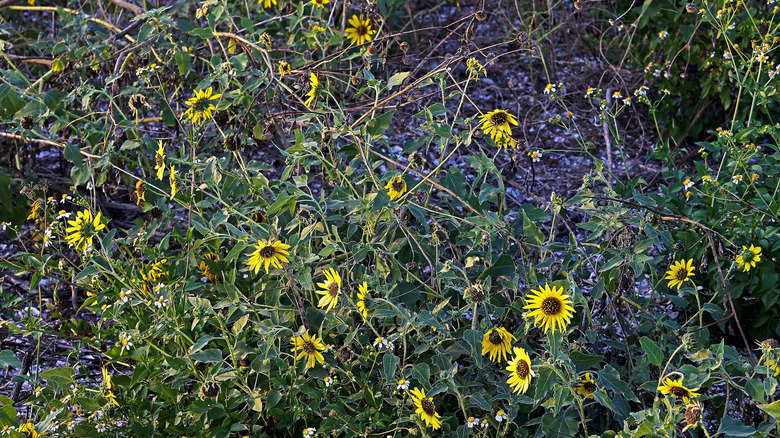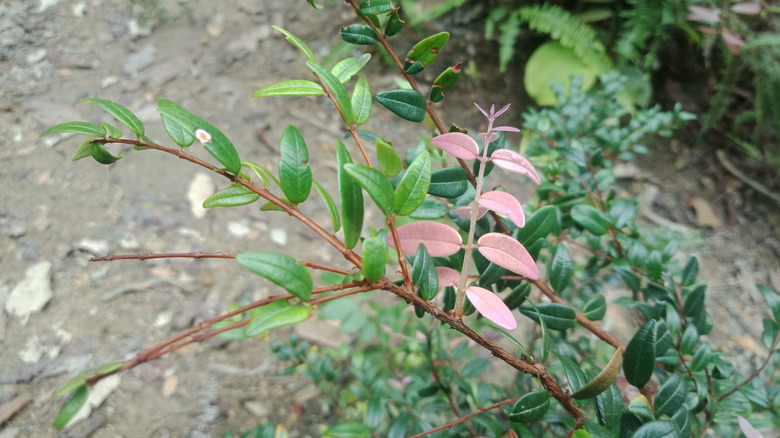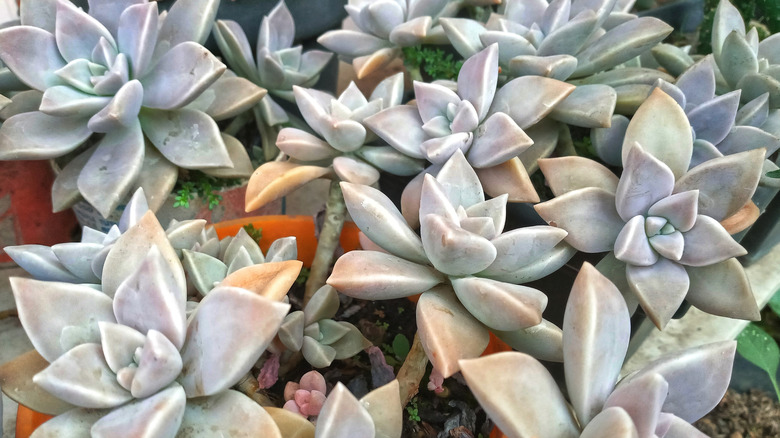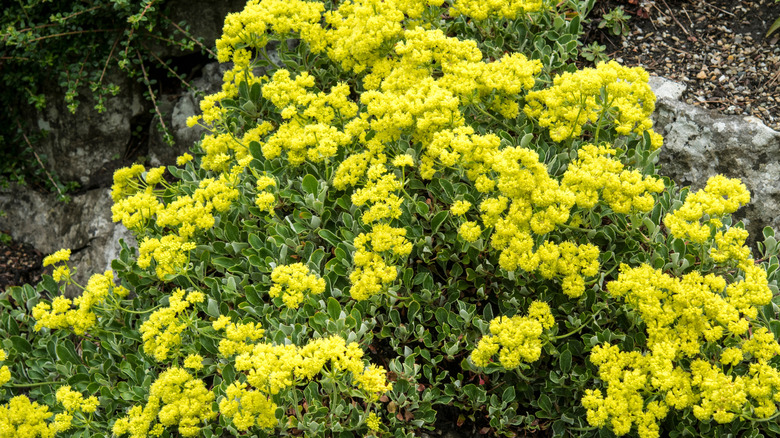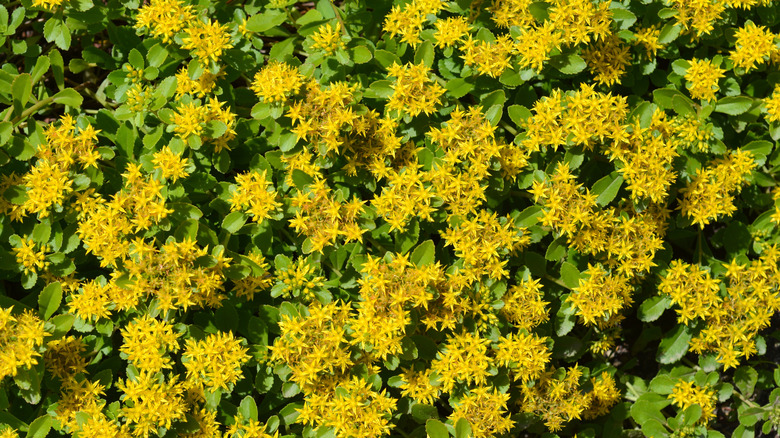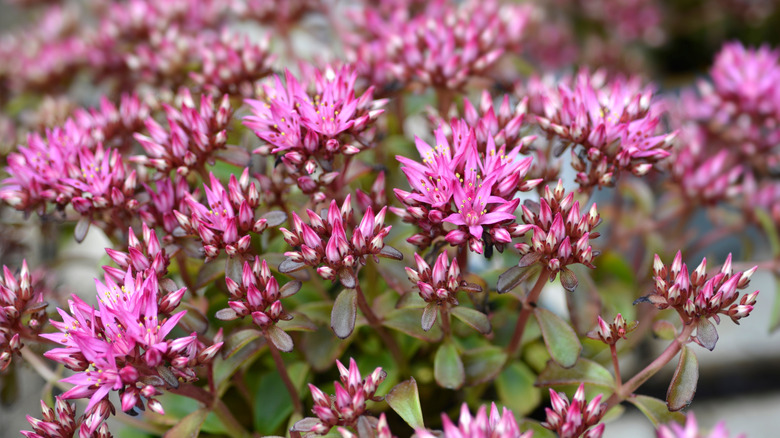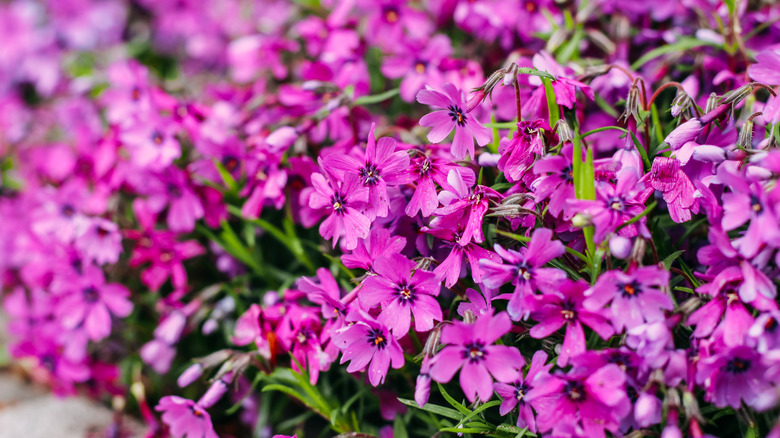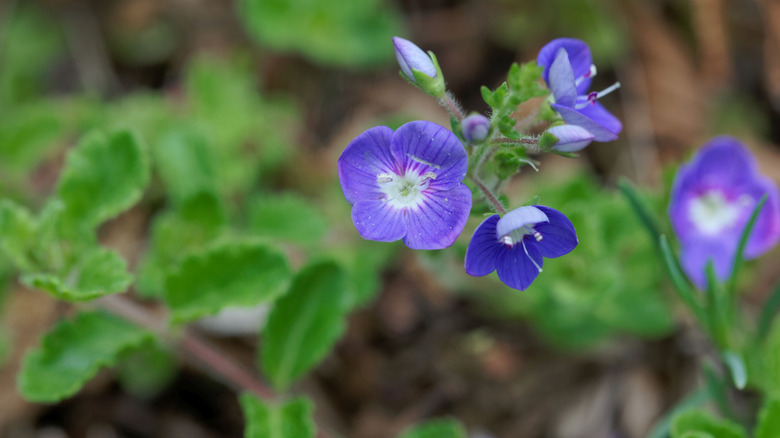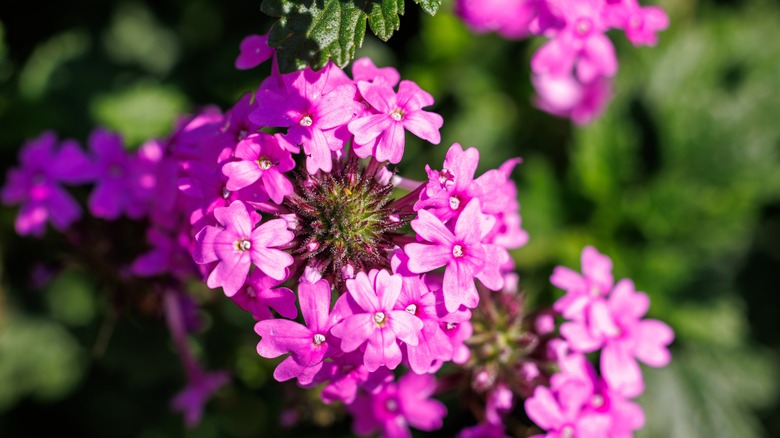Dependable Ground Covers For A Drought-Tolerant Rock Garden
We may receive a commission on purchases made from links.
Rock gardening is one of the most popular forms of xeriscaping — gardening with water conservation as a priority. Not only is it great for sunny spots that are typically too exposed for "traditional" plants, but it's also a way to introduce a new garden aesthetic to an otherwise bare, sad-looking plot of land. Plus, creating a rock garden has ecological benefits, too: They don't use lots of water, so it won't be a problem during drought conditions. Additionally, they give new spots for pollinators to feed from, and they can be a year-round habitat that provides shelter for wildlife and improves biodiversity.
But, not every plant is designed to handle direct sun and drought-like soil conditions. That's why we've rounded up 11 of the best ground covers that are hardy, drought-tolerant, and can turn your muted rock garden setup into a lush paradise. For each ground cover we'll give you the full details on what makes it so dependable as a rock garden plant and a few growing tips to ensure your new plant settles in nicely. So, grab a shovel and let's dive in.
The Eastern prickly pear cactus is perfect for native rock gardens
When people think of rock gardens, they typically picture cacti and succulents — and with good reason: Cacti love to soak up the sun in a rock garden. The Eastern prickly pear cactus (Opuntia humifusa) is an especially great pick for rock gardens, thanks to its need for full sun and its hardy nature, being both drought- and salt-tolerant due to its ability to store water in its pads and shallow roots that soak up water quickly. Plus, it's super easy to grow and spreads around 18 inches per plant, filling in gaps nicely.
Eastern prickly pear is one of the shorter cacti, only topping out around 1 foot high, making it a unique feature in rock gardens. Since it's native to the U.S. and Mexico, it'll also behave nicely in your garden and shouldn't be an issue for diseases or pests. Growing the Eastern prickly pear cactus requires well-draining soil, as it can't tolerate much wetness for too long and should be planted somewhere that gets full sun. Eastern prickly pear is a favorite for gardeners who need a plant that can handle slopes, and its big bursts of yellow or peach flowers make an interesting feature for an otherwise bare spot.
Catsfoot likes gritty soil and is drought-tolerant
Catsfoot (Antennaria dioica) is an interesting option for rock gardens, as its origins might make you think twice. It's one of the few plants on this list not native to the U.S. — it's actually from Northern European grasslands. Yet, catsfoot is still an excellent ground cover for rock gardens, thanks to its ability to thrive in sandy soil, and its slow spread allows it to be drought-tolerant, since it never becomes a resource hog. Catsfoot will only get around 4 inches high, but can spread as wide as 2 feet per plant and it's an excellent climber, making it awesome for covering rocks or cascading over stone walls.
While catsfoot like rocky, gritty soils, it's not the best choice for rock gardens in the deep South as heat and humidity can be too much for this little plant. However, for places with cooler summers, it does just fine. Make sure to plant it somewhere with good drainage or add rocks and gravel to its planting site to help move water away and prevent root rot. Once established, expect to get year-round blooms of purple-gray flowers that some say resemble the pads of a cat's foot, hence the name. However, it's important to note those year-round blooms may cause allergic reactions for someone sensitive to the pollen from ragweed, daisy, marigold, or chrysanthemum.
Chocolate daisies happily thrive in dry, rocky soils
Want to add a little sensory delight to your rock garden? Give the chocolate daisy (Berlandiera lyrata) a try. This native daisy comes from dry, rocky areas of the Southwestern U.S. and Mexico and will grow up to 2 feet square, so it is perfectly suited as a ground cover in a rock garden. Berlandiera lyratas developed their drought tolerance by evolving to have long taproots that can source water deep under the soil. Plus, its happy, yellow flowers emit the smell of chocolate that's most noticeable in the morning, making it a potentially awesome — or dangerous — addition to your garden, depending on your level of self-control around chocolate (we may be speaking from experience).
Chocolate daisies are year-round bloomers in warm weather and are so hardy they can even bounce back after a mowing. Plant a berlandiera lyrata somewhere that's a little more alkaline and full of gravel and sand. Giving it a drink here and there will result in more blooms, but don't overdo it; too much moisture can make the stems droop and result in root rot.
Creeping blueberry can create a dense mat over rock gardens
Creeping blueberry (Vaccinium crassifolium) comes from only four states in the U.S. — Virginia, both Carolinas, and Georgia — but is so dependable as a ground cover that it's a favorite for gardeners with rock gardens around the world. Creeping blueberry can spread up to 3 feet wide per plant and is part of a family (Vaccinium) that evolved to regulate its seed production based on resource availability, allowing it to survive drought conditions easily. It forms a dense mat of leaves that give year-round color, and its pink bell-shaped flowers make this a hardy, but pretty, plant that's full of intrigue.
Creeping blueberries need to either be used in a container or be established in one spot, because they don't take kindly to having their roots disturbed. Creeping blueberry is a "true" blueberry plant, since it's from the Vaccinium family, so fruits are edible and will typically show up in the summer. Like other blueberry plants, this one needs acidic soil that's a little sandy or loamy, and they cannot tolerate soil with lime. Creeping blueberry can handle full sun or partial shade if it has to, but it will just give you the best show in full sun conditions.
The ghost plant is a showstopper in gray rock gardens
Ghost plants (Graptopetalum paraguayense) aren't as spooky as they sound, fortunately (or not). Its name comes from its pale coloring and powdery coating that gives it an ethereal look. This ghostly plant isn't like a waifish, Victorian lady ghost; it's more like one of those poltergeists who refuse to leave, because this plant is hardy and hard to kill. Ghost plants make excellent ground coverings for rock gardens, thanks to their sprawling growth habit and ability to handle harsh weather conditions in desert climates, tolerating temperature swings that run hot in the day and even surviving chilly night temperatures as low as 10 degrees Fahrenheit.
Ghost plants can sprawl as wide as 3 feet per plant, as long as they can access some direct sun and well-draining soil. Their colors will change depending on the amount of sun they get — pinker with more sun and bluer when living in partial shade. They'll become drought-tolerant once established, keeping reserves of water in their plump leaves, but need time to settle in, so keep an eye on them during the first growing season and look out for signs the succulent needs water. Their thick branches give this plant a phenomenal strength that lets them support their big, blue rosettes, even when cascading down a planter or wall.
Sulfur flowers are tolerant of poor soils and can handle droughts easily
Planting sulfur flowers (Eriogonum umbellatum) from seed is like a fun little garden mystery. This native wildflower's appearance is considered highly variable, making each plant unique in its shape and coloring. However, you can expect a dense mat of foliage that will spread up to 3 feet wide per plant and produce clusters of yellow flowers for months on end. Sulfur flowers need to be kept out of moist soils, so they're perfect for rock gardens, and their long taproots may be what gives them such a high drought tolerance.
What's cool about sulfur flowers is their color shift over seasons, changing their foliage from green to a reddish-bronze in the fall. Thankfully, the "sulfur" name doesn't come from its scent, but the yellow color of the flowers, so don't worry that you might've accidentally planted some sort of olfactory horror in your garden. It's also an excellent plant for attracting butterflies and bees to rock gardens, and birds may try to pick up its seeds before you can. Sulfur flowers may self-seed in optimal conditions, but are not considered invasive due to their native designation. Plant your sulfur flowers in an area with full sun and lime-free, extremely well-draining soil, as standing moisture is almost always a death sentence.
Orange stonecrop is a rock garden favorite
Orange stonecrop (Phedimus kamtschaticus) is part of the sedum family, making it a hardy succulent that absolutely loves rock garden habitats. Orange stonecrop is drought-tolerant, thanks to its ability to store water in its leaves, and its adaptable nature makes it great in rock gardens both in-ground or planted in containers. Sedums are also able to establish themselves relatively quickly, so this a no-fuss plant that even new gardeners can handle with ease.
Orange stonecrop will spread around 18 inches per plant, producing clusters of bright yellow flowers throughout the summer that transition into red by the fall. Plant in well-draining soil or a cactus/succulent mix if using a container — Miracle Gro's Cactus, Palm, & Citrus Potting Mix is perfect — and make sure it has full sun. Once your stonecrop settles in, feel free to let it do its own thing without having to worry; this tough-as-nails plant is rabbit, deer, drought, and even air pollution-tolerant.
Creeping stonecrop gives a long-lasting pink splash of flowers
Let's say orange isn't your color. That's okay, because creeping stonecrop (Phedimus spurius) is another option that's full of hot pink, star-shaped flowers. Like its cousin, P. kamtschaticus, creeping stonecrop is a hardy succulent that's drought-tolerant, thanks to the water reserves it keeps in its stems and leaves. Creeping stonecrop will spread as far as 3 feet wide per plant in rocky soil and full sun conditions, making it a natural thriver in rock gardens.
Creeping stonecrop's flowers will last for months, so they're popular with butterflies and other pollinators. Plus, their leaf color varies by cultivar, ranging from green to gold or gray, meaning you can add multiple creeping stonecrops and have a rainbow of foliage without ever needing another species. Though it's not native to the U.S., it nonetheless behaves nicely in these climates and is not considered invasive.
Moss phlox is a dependable staple for poor or rocky soils
Good old moss phlox (Phlox subulata); we've featured it many times as one of the most dependable ground covers, and with good reason. Moss phlox is native to rocky terrains in the Appalachian Mountains of North America, so it's very well adapted to handle rock gardens, spreading out to 3 feet wide per plant and producing hundreds of flowers in spring. While it does appreciate moist soil, it's considered to be drought-tolerant once established, which may be due to its fibrous root system that allows it to suck up water from even the smallest of sources — in addition to its thin leaves that prevent moisture loss.
Moss phlox loves soil that's well-draining, humusy, and somewhat moist, which can be a problem in rock gardens. However, its ability to thrive in its native habitat shows this plant is a champ, and rocky, well-draining soils aren't an issue. Plant your phlox in a space with full sun or dappled shade if your summers are particularly hot and humid. If your plant starts to creep to the point of being leggy, cut the stems back halfway — this will encourage the plant to change its growth strategy into becoming denser and thicker, instead of sprawling.
Thyme-leaf speedwell lives for years and loves rock gardens with slopes
Thyme-leaf speedwell (Veronica oltensis) may look like a delicate flower, but it's built tough. It's a dense mat of foliage that will spread around 2 feet wide per plant, producing the most stunning blue flowers that stand out against its lacy-looking leaves. Thyme-leaf speedwell is native to rocky areas in Turkey, so it's well-adapted to handle rock gardens, and its slow growth lets it conserve water in drought situations.
Be very careful when selecting this plant, as it comes from a rough family. Many plants in the Veronica genus are aggressive spreaders and can overtake their gardens quickly, but Veronica oltensis is a slow grower and easy to control. Plant your thyme-leaf speedwell in an area with full sun, well-draining soil, and let it go — once established, this plant should last for years. Its common name comes from its resemblance to thyme, though it's missing thyme's potent fragrance.
Rose verbena adds a splash of color to rock gardens all season long
Want a showstopper feature for your rock garden? Look no further than rose verbena (Verbena canadensis or Glandularia canadensis). This plant is native to the southern U.S. and can spread up to 2 feet per plant, producing the most gorgeous clusters of pink or purplish flowers throughout the summer. Rose verbena stays low to the ground, using its creeping stems to produce multiple roots, which allows it to source water from a wider region and improve its drought tolerance. It also loves the dry, well-draining soils and full sun conditions typically found in rock gardens.
Rose verbena is one of the taller ground covers, putting on a display that can reach up to 18 inches and makes you take notice. It's a fast grower, self-seeding and sending out stems to creep along the terrain, but isn't considered invasive due to its native designation. However, you may want to keep an eye on it if other plants are within its 2-foot growth radius. Rose verbena is only hardy as a perennial for USDA Zones 5 through 10, and may need to be grown as an annual or given good coverage in colder winter climates.
